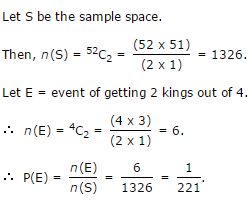Probability is one of the important chapter for SBI Junior Associates and other competitive exams.
- Probability is a measure of how likely an event is to occur.
- Probability is expressed in the form of fractions.
- Favorable number of outcomes
- Total number of outcomes
- Probability ranges between 0 and 1.
Practice Questions:
1.From a pack of 52 cards, two cards are drawn together at random. What is the probability of both the cards being kings?
1. \(\frac{1}{15} \)
2. \(\frac{25}{57} \)
3. \(\frac{36}{256} \)
4. \(\frac{1}{221} \)
Solution:

- 1/5
- 5/18
- 35/216
- 125/648
- 225/1296
Explanations:
2. Rolling any number on a dice three times in a row is equal to the number of throws  , where 3 represents the number of throws and 6 is the number of different ways to get three of the same number (e.g. 1, 1, 1 2, 2, 2 3, 3, 3…).
, where 3 represents the number of throws and 6 is the number of different ways to get three of the same number (e.g. 1, 1, 1 2, 2, 2 3, 3, 3…).
Next we have to use the combinations formula to determine how many ways three out of five can be the same.  . We want to multiply this number to
. We want to multiply this number to 
We are not finished yet – there is one little twist to the problem. The question says “exactly three times.” Meaning we have to discount all the instances in which we roll the same number four times and those instance in which we roll the same number five times.
One way to do so is by multiplying by the probability that the fourth and fifth dice will NOT land on the same number as the three dice. Because there are five other possibilities on dice that will not compromise “exactly three numbers” we can multiply by 
Finally this gives us 


